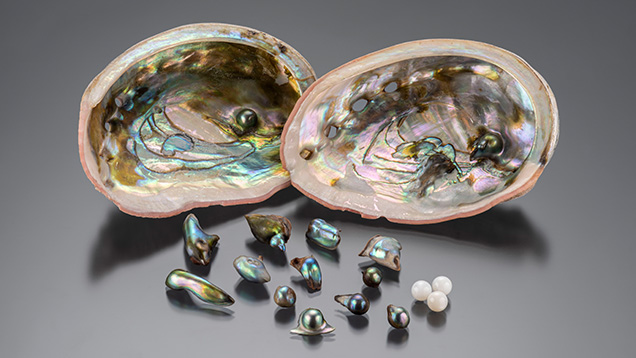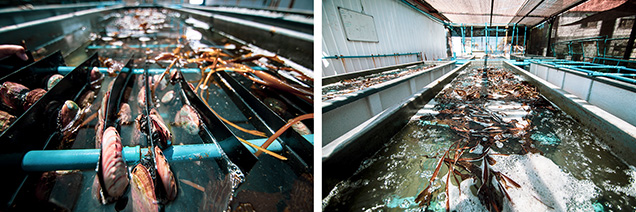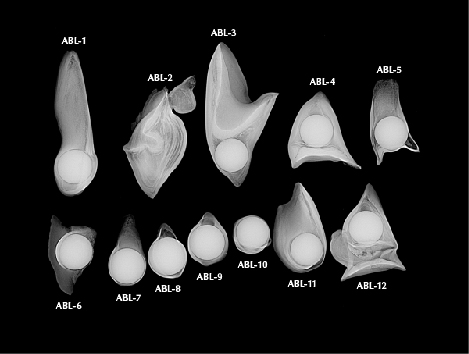Bead Cultured Abalone Pearls from Chile

Abalone is the common name of the marine mollusk species that belongs to the Haliotis genus. Various abalone species are distributed worldwide along cold coastal waters. They live in rocky habitats, attaching firmly with their muscular foot. Abalone is highly prized for its meat, shell, and pearls. Due to a marked decrease of abalone populations, harvesting wild-caught abalone is heavily regulated. Thus, approximately 95% of the global abalone supply comes from farms around the world, in countries such as China, South Korea, South Africa, Chile, Australia, Taiwan, Japan, the United States, and New Zealand (P.A. Cook, “Worldwide abalone production statistics,” Journal of Shellfish Research, Vol. 38, No. 2, 2019, pp. 401–404).
Abalone’s ear-shaped shells and pearls are known for their unique, vibrant iridescent nacre, which is sought after in jewelry and decorative items. The iridescence phenomenon is also known as “orient,” and it is attributed to interference and diffraction of light in the multilayered aragonite platelet microstructure and organic components. Due to the rarity of natural abalone pearls, most abalone products used in jewelry today are either abalone shells or assembled cultured shell blisters (also known as “mabe pearls”).
The culturing of whole pearls in abalone mollusks started around the same time as shell blister culturing for producing mabe pearl (assembled cultured shell blister), and various methods have been attempted over the years (C.Y. Wentzell, “Cultured abalone blister pearls from New Zealand,” Fall 1998 G&G, pp. 184–200; M. Monteforte and H. Bervera, “Abalone pearl culture on the west coast of the Baja California peninsula, Mexico,” World Aquaculture, 2010, pp. 12–17). However, due to abalone’s hemophilia and poor tolerance for chemicals and handling, any significant cut could cause major bleeding, and the nucleation and implantation procedures could induce infection that prohibits the mollusk from producing nacre. Therefore, the success rate of bead cultured (BC) abalone pearls was always low and the pearls were of unmarketable quality.

After 10 years of experimenting, scientists from the University of Antofagasta, Chile, have successfully created abalone BC pearls using a patented method for producing free pearls in abalone. Twelve of their cultured pearls and two abalone shells with a cultured shell blister attached (figure 1) were submitted to GIA for study in May 2022. They were the pilot crop of a new pearl culturing technique using traditional freshwater shell bead nuclei (5 to 8 mm) inserted into grafting channels in the visceral mass of Haliotis rufescens (red abalone) imported into Chile from Mexico in the 1990s (figure 2, left) for abalone farming. The BC pearl cultivation takes place during the last 24–28 months of the abalone culture process that usually takes 48–52 months, allowing the abalone meat and the pearl to be harvested at the same time. The facilities include an aquaculture recirculation system in eight raceways of 5000 liters, with continuous aeration by blowers and a culture water flow of 5000 liters per hour (figure 2, right). The local kelp species Lessonia trabeculata obtained from natural, sustainably managed sources is used to feed the mollusks twice a week. Despite a high rate of bead nucleus rejection, the survival rate of the mollusks after grafting has been 99% and is currently at 15,000 grafted mollusks per trial, according to the farm.

The cultured abalone pearls produced using this method displayed multicolored nacreous surfaces due to strong iridescence, along with patches and stripes of dark brown organic materials. They exhibited a variety of baroque forms, and four samples possessed horn or tooth shapes often found in natural abalone pearls. A characteristic underlying botryoidal-like surface structure, usually observed on natural abalone pearls and shells, was also present (Fall 2015 Lab Notes, pp. 319–320). Real-time microradiography (RTX) revealed a round bead nucleus in the majority of samples, and the nacre layer thickness surrounding the bead nuclei ranged from 0.10 to 1.20 mm (figure 3). One sample lacked a bead nucleus and was identified as a non-bead cultured (NBC) pearl. Its layered growth with void-related features resembled the internal structure commonly found in natural abalone baroque pearls.


Ten natural abalone pearls were selected for spectroscopic and chemical comparison with the cultured pearl samples, and both types of samples showed similar results. No specific patterns were observed in ultraviolet/visible reflectance and photoluminescence spectra, and Raman spectra showed high fluorescence background and weak peaks of aragonite at 704 and 1085 cm–1 (figure 4). Energy-dispersive X-ray fluorescence analysis revealed all the samples had very low or below detection limit manganese content and high levels of strontium ranging from 1100 to 5000 ppm. High iodine levels were also detected in most samples, which is common in abalone. Trace element concentrations determined by laser ablation–inductively coupled plasma–mass spectrometry (LA-ICP-MS) were compositionally similar in both sample types. However, the cultured samples contained lower boron and higher potassium contents. All four tested spots of the NBC samples could be clearly separated from natural samples in the plot of boron vs. potassium contents (figure 5). Since the one NBC pearl showed an internal structure similar to that of natural abalone pearls, the plot can potentially be used to differentiate NBC pearls from natural samples. However, further study on both sample types is required. Additionally, all abalone samples showed higher strontium concentrations than Pinctada species previously studied.
The success of abalone BC pearl production could be a promising addition to the gem and jewelry industry, and this study provided useful information for future reference.



